Exploring the Largest Urban Areas in Asia: Economic Powerhouses
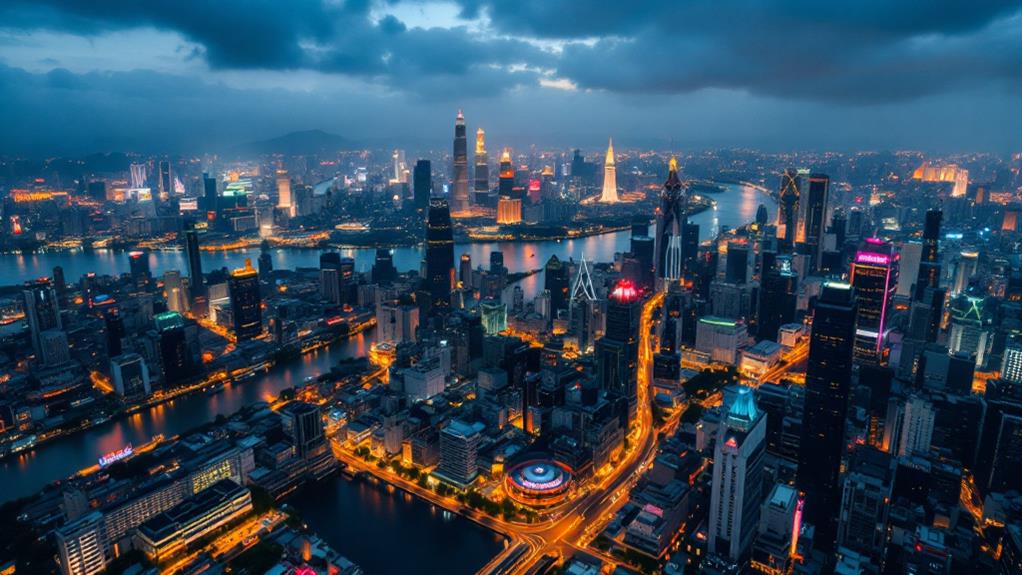
You're entering a dynamic period where Asia's urban areas like Shanghai, Delhi, and Shenzhen rise as economic powerhouses. These cities are not just population giants; they're driving innovation and economic growth globally. Shanghai is set to rank among the top economies, while Delhi's population and disposable income are booming. Shenzhen continues to lead in technology and smart city initiatives. Rapid urbanization is transforming these cities, pushing them to the forefront of the global economic landscape. With consumer markets surging, these economic titans offer rich insights into future trends and opportunities for growth and prosperity. Uncover what's coming next.
Global Economic Shift to Asia
In recent years, Asia has emerged as a formidable force in the global economy, with cities like Delhi, Shanghai, and Shenzhen leading the charge. This global economic shift is reshaping the landscape, as these major cities become critical hubs for urban economic growth and opportunity. With Asia projected to dominate the global economic stage by 2050, it's evident that emerging markets in the region are driving this transformation.
From 2015 to 2021, Asia accounted for an impressive 57% of global GDP growth, underscoring its crucial role in international economic activity. As consumer markets expand, cities such as Ho Chi Minh City and Manila are witnessing noticeable increases in disposable income. This rise is propelling them into prominence as influential economic centers. The growing affluence of these urban areas highlights the region's economic expansion and its potential to sustain future growth.
Rapid Urbanization Trends
Asia's economic rise isn't just a story of growing GDP; it's also about the remarkable urbanization sweeping across the continent. As you look towards the future, you'll notice that rapid urbanization trends are setting the stage for significant urban population growth. By 2033, it's expected that 61% of the global population will reside in urban areas. Emerging markets in Asia will drive this shift, accounting for 95% of the urban population growth over the next decade. This trend not only underscores the continent's role as a global economic powerhouse but also highlights the concentration of economic activities in these urban hubs.
You can expect to see a dramatic expansion in urban consumer markets. By 2033, the number of developing cities with consumer markets exceeding USD 50 billion is anticipated to nearly double. Cities like Delhi, Ho Chi Minh City, and Manila are poised for major growth, enhancing their economic contributions and expanding consumer bases. As these urban areas grow, they'll become key drivers of innovation and economic growth, requiring substantial real estate development to accommodate the rising populations. This urbanization isn't just reshaping cities; it's transforming Asia's role in the global economic landscape.
Key Economic Hubs
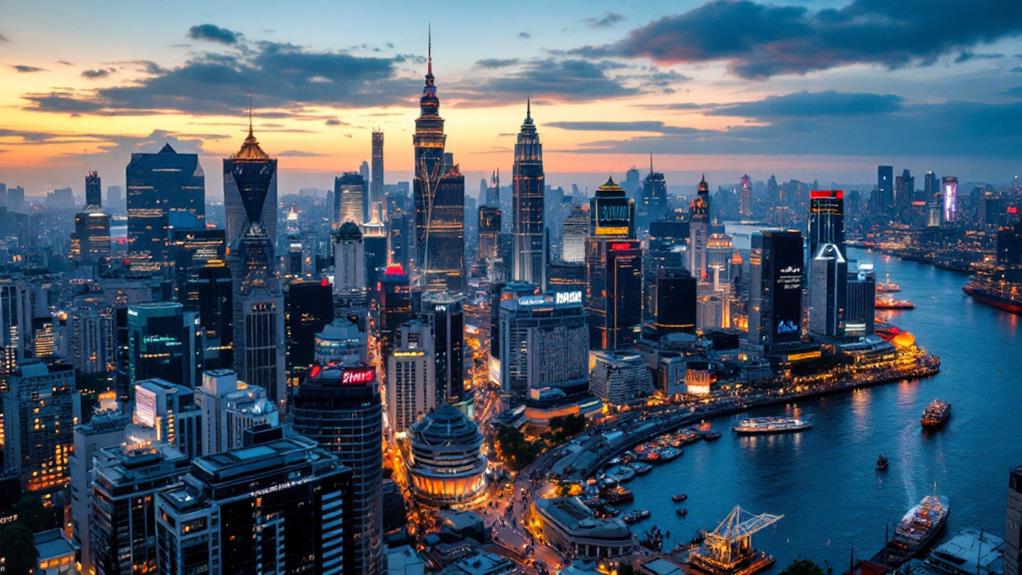
When you think of key economic hubs in Asia, cities like Shanghai, Delhi, and Shenzhen certainly come to mind. These urban powerhouses are at the forefront of economic growth, driving emerging economies to new heights. Shanghai is poised to become one of the top three global economic powerhouses by 2050, thanks to its impressive GDP growth and rapid urbanization. As China's largest city, it offers endless market opportunities for businesses and investors.
Delhi, another standout, is on track to become the largest city globally by population, reaching 47 million. This demographic surge is a catalyst for significant economic expansion, making it a crucial player among Asian cities.
Shenzhen, often dubbed China's Silicon Valley, is a thriving technology hub. Home to major tech companies, it leads in innovation and patent applications, underscoring its economic clout.
Consider these key points about these cities:
- Shanghai: Projected top global economic powerhouse by 2050.
- Delhi: Expected to be the world's largest city by population, driving economic expansion.
- Shenzhen: Prominent technology hub with a focus on innovation and patents.
Each of these cities illustrates how strategic investments and an educated workforce can transform urban centers into global economic leaders.
Infrastructure and Innovation
Urbanization across Asia is rapidly transforming cities into dynamic hubs of infrastructure and innovation. With rapid growth in urban economic sectors, cities like Shanghai and Delhi are investing heavily in transportation, energy, and housing. These developments support burgeoning populations and thriving economies, ensuring that infrastructure keeps pace with rising demands. In Shenzhen, known as China's Silicon Valley, the focus on advanced transportation systems and smart city initiatives fosters connectivity and drives tech innovation.
In Ho Chi Minh City, the real estate market is thriving, with ongoing developments catering to the increasing need for office and retail spaces. This positions the city as a key technology hub in Southeast Asia, drawing multinational investments and fueling further urban economic expansion. Meanwhile, Kuala Lumpur utilizes its strategic geographical position and infrastructure improvements to improve its business environment, making it a highly livable city and an attractive magnet for talent and investment.
Sustainability is increasingly prioritized in urban infrastructure across major Asian cities. The adoption of low-carbon buildings not only raises energy efficiency but also greatly elevates property values and tenant satisfaction, aligning with the broader goals of sustainable urban development and innovation.
Rising Consumer Markets
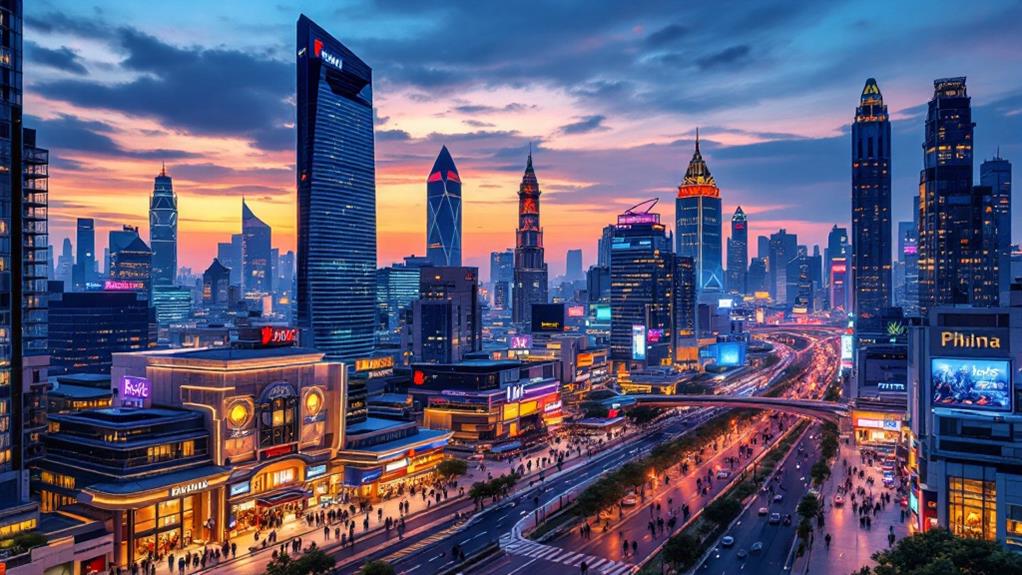
The transformation of Asia's cities into thriving consumer markets is reshaping the region's economic landscape. In emerging Asia, rapid urbanization and economic growth are creating exciting market opportunities. By 2033, 18 megacities are projected to see disposable income per capita soar by over 50%, signaling a surge in consumer purchasing power. Cities like Ho Chi Minh City and Manila are becoming crucial in the global value chain, thanks to foreign investments driving their urban consumer markets.
With these changes, you'll find that Southeast Asia and India are leading the income growth charge. Delhi, for instance, is expected to experience a 73% increase in disposable income. As Asian cities develop, the number of consumer markets exceeding USD 50 billion will likely double by 2033, highlighting substantial economic expansion. This presents businesses with a golden opportunity to tap into more affluent consumer bases.
Here are three key points to reflect on:
- Economic Growth: Rapidly growing disposable incomes are enhancing consumer spending.
- Urbanization: Expanding urban areas are fostering larger consumer markets.
- Market Opportunities: Businesses can capitalize on evolving spending habits in emerging cities.
These factors are creating a dynamic environment for growth and innovation.
Real Estate Opportunities
As consumer markets in Asia's rapidly growing cities expand, real estate opportunities are flourishing alongside. Rapid urbanization in cities like Delhi, Shanghai, and Ho Chi Minh City is driving significant demand for diverse real estate types. These cities, with their growing populations and economic activity, represent key investment opportunities. An increase in disposable income, projected at 73% in Delhi, improves consumer spending power, stimulating demand for both residential and commercial properties.
Infrastructure development is crucial in emerging urban centers. Cities like Bangalore and Shenzhen are creating a favorable environment for real estate investments by attracting international companies and talent. This growth presents vast market opportunities for investors looking to capitalize on this economic momentum. Additionally, the rise of e-commerce and digital services leads to undersupplied markets for logistics and data centers across rapidly urbanizing cities in Southeast Asia.
In Ho Chi Minh City, ongoing real estate development aims to meet the increasing demand for office and retail spaces. Investments from multinational firms and a young, educated workforce drive this demand. By engaging with these booming urban areas, you can reveal substantial potential in Asia's dynamic real estate market.
Middle Class Expansion
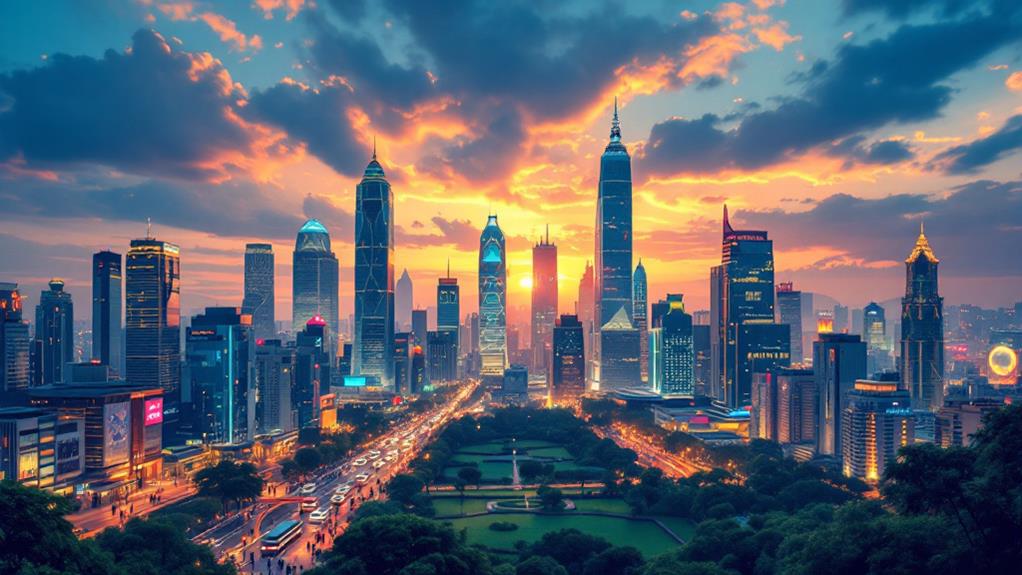
How is the middle-class expansion reshaping Asia's economic landscape? You're witnessing a transformative period where middle-class expansion is fueling unprecedented economic growth across the region. As of 2021, Asia accounts for 56% of the world's middle-class households, offering tremendous potential for consumer spending. Emerging Asian megacities such as Delhi, Ho Chi Minh City, and Manila are at the forefront of this shift, with rapid urbanization leading to a surge in disposable income and discretionary spending.
Consider the following impacts of this expansion:
- Rising Disposable Incomes: Cities like Delhi are expected to see a 73% increase in disposable income, making them hotspots for consumer spending and economic activity.
- Affluent Consumer Base: By 2033, emerging megacities are projected to experience over a 50% rise in per capita disposable income, fostering a more affluent consumer base keen to spend.
- Growing Consumer Markets: With Asia's economic transformation, the number of developing cities with consumer markets exceeding USD 50 billion is anticipated to nearly double by 2033.
This middle-class expansion not only propels economic growth but also enriches the urban lifestyle, positioning these cities as dynamic hubs of global economic activity.
Future Economic Projections
Emerging from the wave of middle-class expansion, Asia's future economic landscape looks incredibly promising. As urbanization continues to accelerate, it's projected that by 2050, cities like Delhi, Shanghai, and Shenzhen will rank among the top 10 global economies. This reflects significant economic growth and market opportunities in Asia. With Delhi anticipated to become the largest city globally, boasting a population of 47 million, you're looking at a 73% increase in disposable income by 2033. Such growth positions Delhi as an essential player in global consumer markets.
Shanghai's economic trajectory is similarly impressive. Its GDP is set to surpass those of Tokyo, Los Angeles, and London, driven by China's rapid economic expansion and urbanization. These developments highlight Asia's potential as a powerhouse of economic growth. Furthermore, the number of developing Asian cities with consumer markets exceeding USD 50 billion is expected to nearly double by 2033, signaling substantial market growth opportunities.
This rapid urbanization is projected to push 61% of the global population into urban areas by 2033. You'll see concentrated economic activity and a surge in infrastructure development, further establishing Asia as a hub of dynamic economic transformation.
Investment and Market Strategies
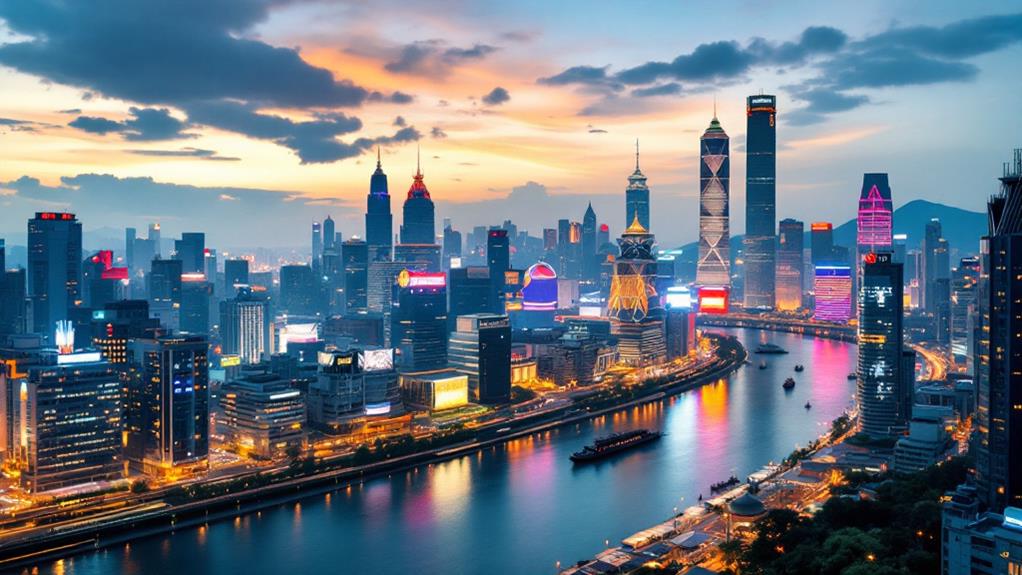
Despite the challenges, Asia's rapid urbanization and economic growth present a wealth of investment opportunities that savvy investors shouldn't overlook. As cities like Delhi and Ho Chi Minh City project noteworthy increases in disposable income, you're looking at a consumer market potential surge of over 50% by 2033. This makes these Asian cities prime targets for strategic investments. The swift urbanization and economic expansion in Bengaluru and Shenzhen are generating high demand for commercial and residential real estate. By capitalizing on these opportunities, you can position yourself advantageously in these burgeoning markets.
To effectively engage with these dynamic consumer markets, you must develop market strategies tailored to local preferences and emerging trends. Asian cities like Shanghai and Manila are on the rise, and understanding their unique consumer behaviors can greatly enhance your returns. Anticipated economic growth implies that more developing cities will soon have consumer markets exceeding USD 50 billion by 2033.
Here are three key strategies to contemplate:
- Focus on cities with rapid economic growth for long-term investments.
- Diversify investments across commercial and residential real estate sectors.
- Adapt to local consumer preferences to optimize market potential.



